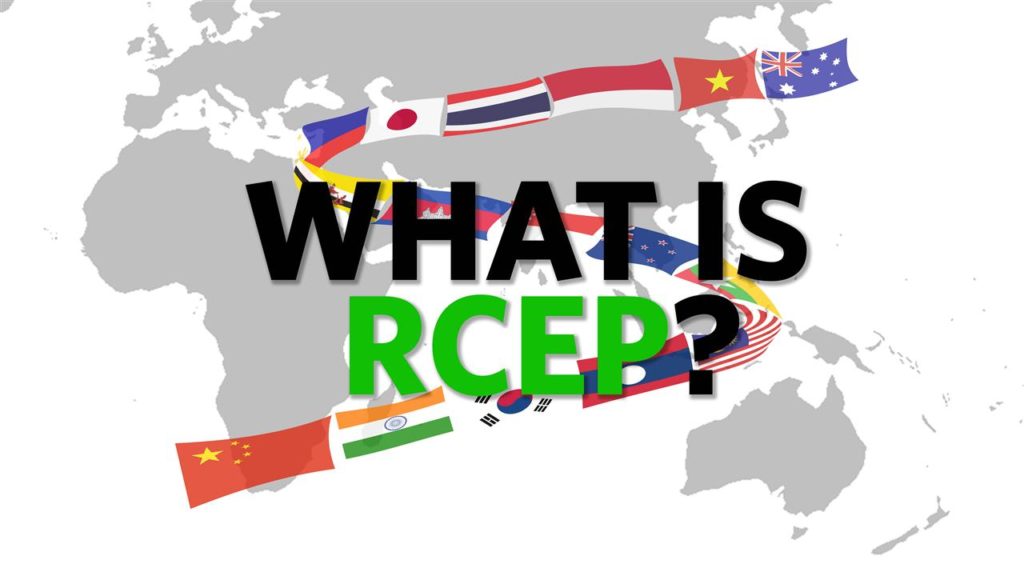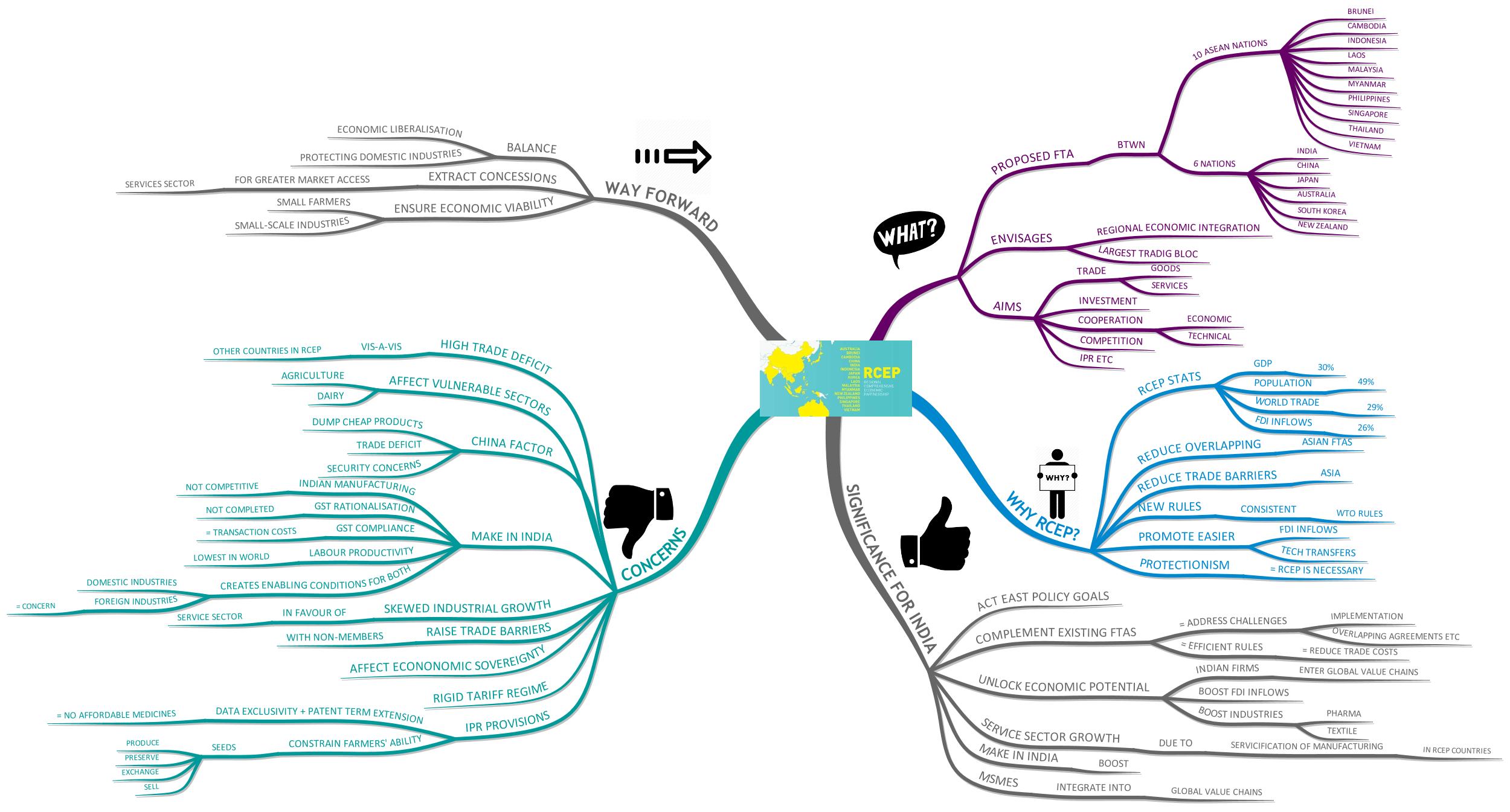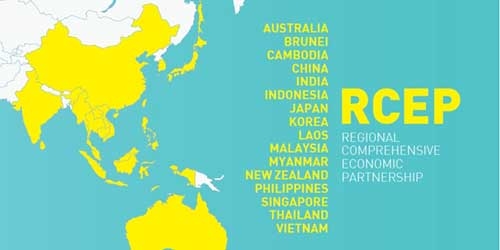Regional Comprehensive Economic Partnership (RCEP) – Why India Opted Out?

From Current Affairs Notes for UPSC » Editorials & In-depths » This topic
IAS EXPRESS Vs UPSC Prelims 2024: 85+ questions reflected
First Published: Feb 8, 2019
Updates*
India’s participation in the mega-trade agreement, Regional Comprehensive Economic Partnership (RCEP) has long been debated and sentiments around the subject are quite divided and divergent. Critics warned that India must exercise caution before signing RCEP which goes far beyond trade liberalisation to impose a common set of rules on investment and IPRs.
Recently, India decided to exit the 16-nation Regional Comprehensive Economic Partnership (RCEP) trade deal. India mentioned that it will not become part of RCEP until “significant outstanding issues” are addressed.*
What is the Regional Comprehensive Economic Partnership (RCEP)?
- RCEP is a proposed free trade agreement (FTA) between the 10 ASEAN countries (Brunei, Cambodia, Indonesia, Laos, Malaysia, Myanmar, the Philippines, Singapore, Thailand & Vietnam) and the 6 countries which ASEAN has existing FTAs – India, China, Japan, Australia, South Korea, and New Zealand.
- The grouping envisages regional economic integration, resulting in the creation of the largest trading bloc in the world, accounting for nearly 45% of the world’s population with a combined GDP of $21.3 trillion.
- It aims at covering trade in goods and services, investment, economic and technical cooperation, competition, intellectual property etc.
- RCEP negotiations were formally launched in November 2012 at the ASEAN Summit in Cambodia.
Why RCEP?
- The RCEP member countries represent 49% of the world’s population and account for 30% of world GDP. It also makes up 29% of world trade and 26% of world FDI inflows. According to estimates if the RCEP is implemented it would bring large income gains to not only Asia but the world economy.
- RCEP will also reduce the overlapping between Asian FTAs.
- RCEP will reduce the trade barriers in Asia and the new rules will be consistent with WTO agreements.
- RCEP will promote easier FDI flows and technology transfers by multinational corporations
- With the rise of protectionism across the world (ex-US & China), RCEP is important for promoting free trade in the region.
How RCEP is significant for India?
Act East Policy:
For India, the RCEP provides a decisive platform to influence its strategic and economic status in the Asia-Pacific region and realise the goals of its “Act East Policy”.
Complement existing FTAs:
- The RCEP agreement would complement India’s current FTAs with the ASEAN+6 countries = address challenges of implementation issues, overlapping agreements etc.
- Thus RCEP will make rules and regulations for doing trade more efficient = reduce trade costs.
Unlock the true potential of the Indian economy:
- RCEP is expected to harmonize trade-related rules, investment and competition regimes of India with those other countries in the group = Indian companies could enter the regional and global value chains and unlock the true potential of Indian economy.
- It will give a boost to Foreign Direct Investment (FDI) in India.
- RCEP will especially boost textile and pharma industries as it will facilitate the removal of trade barriers such as sanitary and phyto-sanitary measures of these products.
Services sector growth:
- Besides facilitating Foreign Direct Investment (FDI), the RCEP will create opportunities for Indian Service Sector companies to access new markets.
- It is because the manufacturing structure in many of these countries is becoming more and more service oriented. This phenomenon is known as Servicification of manufacturing.
Make in India:
Make in India will become a global success if India becomes a part of the Asian Value and Supply Chain.
MSMEs:
RCEP will also facilitate MSMEs to effectively integrate into the regional value and supply chains, thus promoting their growth.
What are the concerns for India joining RCEP?
Trade deficit:
India’s trade deficit (Imports > Exports) with various countries have always widened after signing FTAs with them. Example- ASEAN, Japan, Korea, and Singapore, most of which are RCEP nations.
Vulnerable sectors:
India’s vulnerable agriculture and dairy sectors will be exposed to vagaries of global trade as India is not in a position to compete with Australia and New Zealand, the top performers in these sectors.
The China factor:
- India fears that the RCEP pact will enable China to dump its products at lower prices and finally capture the market.
- India’s trade deficit with China is already at $63 billion which will further rise if India joins RCEP.
- Security concerns have also arisen over Chinese companies influencing market trends in sectors like telecommunication.
Make in India:
- Indian manufacturing is not competitive enough to face the consequences of a free trade regime.
- Rationalisation of multiple GST rates is still a work-in-progress.
- The compliance with the complex GST norms adds to the transaction costs.
- Labour productivity in manufacturing in India is still one of the lowest in the world with regionally fragmented labour laws increase the cost of doing business.
- Make in India seeks to create enabling conditions not only for domestic industries but also for foreign industries = more competition.
- Considering the above issues, the Indian industry is hardly in a position to compete in a free trade region.
Skewed sectorial growth:
- The issue of trade liberalisation in services is still a bone of contention among RCEP Nations.
- India wants to capitalise on its pool of skilled labour from improved access to these economies.
- Thus it sought binding commitments to simplify services trade.
- India is even willing to trade up its remaining tariff policy powers in the manufacturing sector to get these concessions for services sector in RCEP.
- However, given the situation of the manufacturing and agriculture sectors in India, it is definitely not a good idea to sacrifice them for the services sector. It will promote the skewed nature of sectorial growth.
Raising trade barriers with non-members:
- A preferential trade agreement such as RCEP provides preferential access to certain products by reducing trade barriers such as tariffs for member countries and not for others.
- Hence, a preferential reduction of trade barriers = raise in relative trade barrier against non-members countries of RCEP.
Affect economic sovereignty:
Harmonisation of foreign investment rules and IPR laws = take away India’s ability to calibrate trade policies according to its needs.
Rigid tariff regime:
- India needs a tariff regime that must be flexible enough to allow tariffs to be calibrated.
- Such flexibilities are provided by WTO’s tariff regime, but not in other FTAs like RCEP.
IPR provisions:
- Japan and South Korea are proposing intellectual property provisions referred to as TRIPS-plus, which go far beyond the obligations under the WTO’s agreement on Trade-Related Aspects of Intellectual Property Rights (TRIPS). The proposed provisions seek to extend pharma firms’ patent terms beyond the usual 20 years (patent term extensions) and also require data exclusivity that limits competition by encouraging monopoly. These will hit our access to affordable medicines.
- Issues related to Intellectual Property Chapter, particularly pacts that constrain our farmers’ ability to produce, preserve, exchange and sell seeds need to be rejected. If India makes any agreement like the International Union of New Plant Varieties (UPOV) 1991 (that favours multinationals and is against farmers’ interests), it will kill the livelihood of our farmers.
Thus, there are several consequences that may arise in both the short and long run, and they need to be considered before India sign up for RCEP.
What India should do?
- India needs to maintain a balance between the opening of its economy and protecting its domestic manufacturing industry. In the current scenario of growing protectionism, Regional Comprehensive Economic Partnership provides an opportunity for the countries to prosper by increasing trade, creating jobs and other economic opportunities and India should make use of such an agreement.
- India must try to extract meaningful concessions for enhancing market access for its services sector.
- India should also ensure the economic viability of small farmers and small-scale industries in the face of relentless import competition.
Updates: *
If you like this post, please share your feedback in the comments section below so that we will upload more posts like this.




